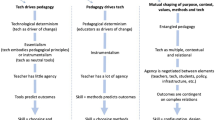Abstract
Many authoring tools have been proposed in an attempt to find more effective ways to face the challenge of developing educational software. However, most of them are reported to be restrictive, since they are strongly connected to a specific educational software development methodology. The AIDA (Ambiente Integrado para o Desenvolvimento de Aplicações educacionais) authoring environment was developed at the University of Coimbra having as its main objectives the support of most of the activities involved in authoring and making educational software development easier. The AIDA system is based on a design module, i.e. a prototyping tool allowing the creation of Windows-based software, including multimedia features. The system assists evaluation activities and it caters also for support on translation and cultural adaptation, as well as on the reutilization of educational materials. The use of the AIDA environment is illustrated by three small examples using different development methodologies.
Similar content being viewed by others
References
Alessi, S. and Trollip, S. (1985) Computer-based instruction — methods and development. Englewood Cliffs, NJ: Prentice-Hall.
Baker, M. and Bessière, C. (1992) Intelligent multimedia authoring: advancing towards users in a European context. In S. Cerri and J. Whiting (eds) Learning Technology in the European Communities (pp. 653–66). Dorchester: Kluwer Academic.
Collis, B. and De Diana, I. (1990) The portability of computer-related educational resources: an overview of issues and directions. Journal of Research on Computing in Education 23(2), 147–59.
Crossley, K. and Green, L. (1990) Le design des didacticiels. Paris: ACL Editions.
De Jong, T., vanJoolingen, W., Scott, D., deHoog, R., Lapied, L. and Valent, R. (1994) SMISLE: system for multimedia integrated simulation learning environments. In T. De Jong and L. Sarti (eds) Design and Production of Multimedia and Simulation-Based Learning Material (pp. 133–65). Dorchester: Kluwer Academic.
Hannafin, K. and Mitzel, H. (1990) CBI authoring tools in post-secondary institutions: a review and critical examination. Computers and Education 14(3), 197–204.
Henson, K. and Knezek, G. (1991) The use of prototyping for educational software development. Journal of Research on Computing in Education 24(2), 230–9.
Marcelino, M. J. and Mendes, T. (1990) Computer-aided pedagogical design: How far are we? Paper presented at the Eurit'90 Conference, Herning, Denmark, 25 April 1990.
Marcelino, M. J. and Mendes, T. (1995) SIM-BEST — a set of integrative tools to support the development of computer-based educational simulation programs. In J. Tinsley and T. van Weert (eds) Proceedings of the sixth IFIP World Conference on Computers in Education. pp. 941–51. London: Chapman & Hall.
Mendes, A. and Mendes, T. (1995a) Linguistic and cultural versionning of educational software. In T. Sechrest, M. Thomas and N. Estes (eds) Leadership for Creating Educational Change: Integrating the Power of Technology. Proceedings of the 12th International Conference on Technology and Education, University of Texas, Austin, 28 February 1995, pp. 185–7.
Mendes, A. and Mendes, T. (1995b) The AIDA approach to educational software portability. Journal of Research on Computing in Education 27(4), 425–34.
Mendes, A. J. (1995) O sistema AIDA: ambiente integrado para o desenvolvimento de aplicações educacionais, unpublished PhD thesis, Department of Informatic Engineering, University of Coimbra (in Portuguese).
Mispelkamp, H. and Sarti, L. (1994) DISCourse: tools for the design of learning material. In T. De Jong and L. Sarti (eds) Design and Production of Multimedia and Simulation-Based Learning Material. (pp. 45–60). Dorchester: Kluwer Academic.
Pelgrum, W. and Plomp, T. (1993) The world-wide use of computers: a description of main trends. Computers and Education 20(4), 323–32.
Schoenmaker, J., van der Mast, C. and Moonen, J. (1986) A methodology for the development of educational software. In J. Moonen and T. Plomp (eds) EURIT'86 Developments in Educational Software and Courseware. pp. 235–42. Oxford: Pergamon Press.
Ten Brummelhuis, A. and Plomp, T. (1993) Lessons from two Dutch projects for the introduction of computers in schools. Computers and Education 20(4), 333–40.
Ulloa, A. (1994) Open system for collaborative authoring and re-use. In T. De Jong and L. Sarti (eds) Design and Production of Multimedia and Simulation-Based Learning Material. (pp. 83–97). Dorchester: Kluwer Academic.
Watson, D. (1988) A CAL development team in the process of change. Computers and Education 12(1), 73–8.
Author information
Authors and Affiliations
Rights and permissions
About this article
Cite this article
Mendes, A.J., Mendes, T. AIDA: a methodology independent support tool for educational software authoring. Educ Inf Technol 1, 55–74 (1996). https://doi.org/10.1007/BF00144336
Issue Date:
DOI: https://doi.org/10.1007/BF00144336




